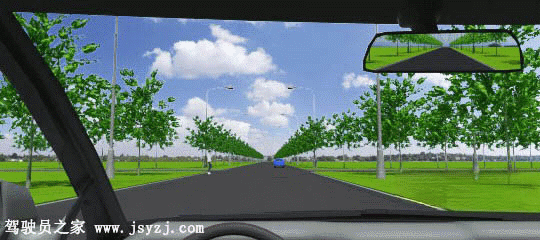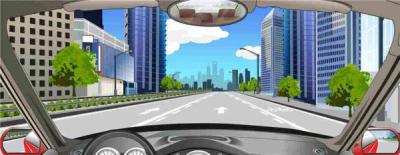1、What should the driver do when the motor vehicle encounters this situation?

A、Overtake immediatel
B、Sound the horn continuously to warn
C、Maintain safety distance and overtake
D、Sound horn and speed up to overtake
Answer:C
2、When there is a braking failure on a downhill road, what should not be done by the driver?
A、Steering the motor vehicle to the uphill direction
B、Stopping the vehicle by rubbing the vehicle body against the rocks or trees on roadside
C、Driving to the emergency lane and stop the vehicle there
D、Pulling up the stopping brake or change the gear to two positions lower
Answer:D
3、When driving on a muddy road, the driver should hold the steering wheel firmly and speed up to pass through.
A、Right
B、Wrong
Answer:B
4、How should the driver use vehicle lights when the motor vehicle leaves a roundabout?

A、Turn on the left-turn indicator
B、Turn on the hazard lamps
C、No need to turn on any indicators
D、Turn on the right-turn indicator
Answer:D
5、Motor vehicles are permitted to move to the right lane at this intersection.
A、Right
B、Wrong
Answer:B
6、Mr Peng drove a heavy semi-trailer tractor with 37.7 tons of cargo(capacity 25 tons). When descending a slope on the Daguang Expressway, the tractor had a rear-end collision with Mr. Li's heavy dump truck ( carrying 3.17 cubes of loess and 24 passengers in the container)occupying the emergency lane. As a result of this accident, 16 people were killed and 13 injured What are the main illegal acts in this case?
A、Mr Peng exceeded the speed limit
B、Mr. Peng's tractor carried more cargo than limited
C、Mr Li illegally drove in the emergency lane
D、Mr. Li's truck illegally carried passengers in the container
Answer:BCD
7、How to reduce speed or stop when driving on a road covered with snow and ice?
A、Take full advantage of driving brake
B、Take full advantage of the control power from engine
C、Take full advantage of parking brake
D、Take full advantage of speed retarder
Answer:B
8、When encountering a situation like changing to a left lane, motor vehicle drivers should vield.

A、Right
B、Wrong
Answer:A
9、The road marking on the right lane indicates that drivers may temporarily borrow the special lane for buses.

A、Right
B、Wrong
Answer:B
10、The sign on the right indicates that the vehicle should yield to the oncoming traffic as approaching each other.

A、Right
B、Wrong
Answer:B
11、When a motor vehicle encounters thick fog on an expressway and the visibility is poor, the driver should immediately brake and stop.
A、Right
B、Wrong
Answer:B
12、The sign on the right warns of a guarded railway intersection ahead.

A、Right
B、Wrong
Answer:B
13、what should motor vehicle drivers do under the circumstances shown in the flash?

A、Reduce speed or stop to yield
B、Sound the horn to warn the pedestrians to yield
C、Pass before the pedestrians
D、Immediately change to another lane to bypass the pedestrians
Answer:A
14、Under such circumstances at a congested intersection, what should motor vehicle drivers do?

A、Force the vehicle to go back to its original lane
B、Closely follow the vehicle in front and refuse to yield
C、Politely yield and pass through
D、Sound the horn and turn on the head lamps
Answer:C
15、The diamond-shaped broken line warns that drivers should drive at a lower speed on the road sections ahead.

A、Right
B、Wrong
Answer:A
16、As shown in this picture, the vehicles intending to turn left are not allowed to drive into left-turn waiting area directly to wait for green light.

A、Right
B、Wrong
Answer:B
17、If a motor vehicle enters a driving lane under this situation, what should the driver do?

A、Control the driving speed and follow the last vehicle
B、Speed up and cut in front of the second vehicl
C、Speed up and cut in front of the first vehicle
D、Cut in between two vehicles at will
Answer:A
18、Mr. Zhao (with an A2 driving license) drove a large sleeper coach on the No. 219 National Road in Yecheng County. When passing a curve at the spot of 226 kilometers mark by 215 meters on the road, the coach fell into the ravine on one side, killing16 people and injuring 26. What's the main illegal act committed by Mr Zhao?
A、Carrying more passengers than permitted
B、Driving a motor vehicle having failed to accept inspection in time
C、Driving an unpermitted vehicle type
D、Fatigued driving
Answer:C
19、When driving on an expressway which of the following statements is correct?
A、Drivers may stop to pick up or drop off passengers in the emergency lane
B、Drives may load or unload cargo in the emergency lane
C、Drives may overtake other vehicles or stop in the deceleration or acceleration lane
D、Drives are prohibited from driving or stopping in the emergency lane in a non-emergency case
Answer:D
20、In order to keep safe when driving on the highway, which ones of the following statements are prohibited acts?
A、Reversing, moving against regulations, making a U-turn by crossing the central divider, or stopping in the lane.
B、Riding or rolling on the lane-dividing line or driving on the shoulder
C、Overtaking on ramps, accelerations lanes, ordeceleration lanes.
D、Testing vehicles or learning to drive a vehicle
Answer:ABCD